While you're reading this, three of your competitors are implementing something that will give them a 12-24 month operational advantage. They're not buying faster computers or hiring more staff. They're deploying multi-agent AI orchestration systems that work 24/7, never make the same mistake twice, and get smarter with every transaction.
The uncomfortable truth: By late 2026, enterprises running teams of specialised AI agents will operate at a fundamentally different efficiency level than those still using traditional automation—or worse, manual processes.
Australian business owners and executives face a perfect storm: rising operational costs, labour shortages, increasing compliance complexity, and relentless competitive pressure. Multi-agent AI orchestration isn't just another technology buzzword—it's becoming essential infrastructure for competitive survival.
This guide provides everything you need to understand, evaluate, and implement enterprise process automation services in your Australian business. No fluff, no jargon—just practical insights from two decades of enterprise development experience.
What Is Multi-Agent AI Orchestration? (Plain English Explanation)
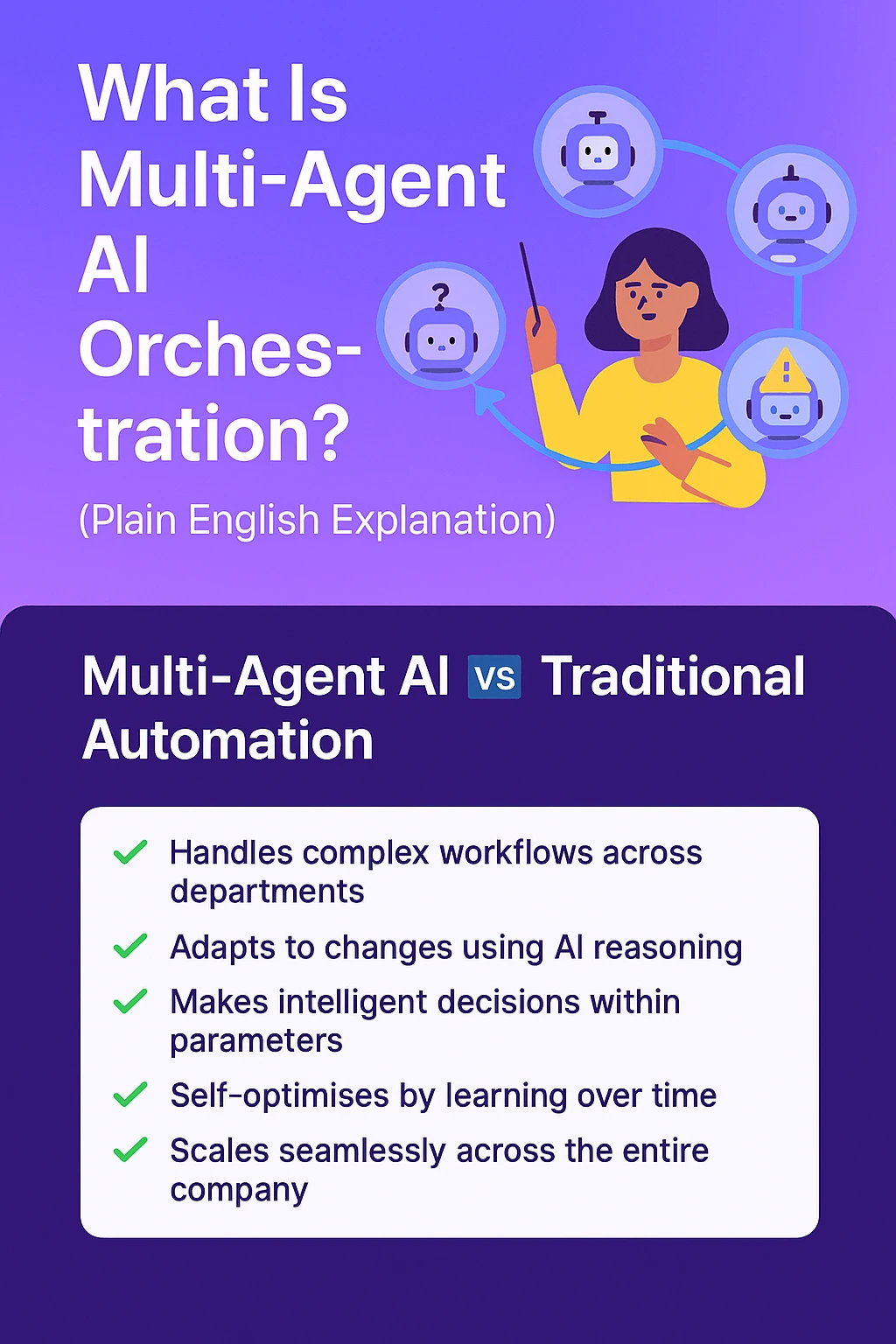
Imagine running a business where instead of one overworked operations manager trying to handle every process, you have a team of specialists: one expert handles customer enquiries, another manages inventory, a third processes invoices, a fourth monitors compliance, and a "conductor" coordinates them all seamlessly.
That's multi-agent AI orchestration. Each AI agent is specialised for specific tasks, and an orchestrator manages how they work together across your systems.
Why This Matters More Than Traditional Automation
Traditional RPA (Robotic Process Automation) handles one task at a time, breaks when processes change, and requires constant maintenance. It's limited to repetitive, rule-based tasks and can't make decisions or adapt.
Multi-agent AI orchestration is fundamentally different:
✅ Handles complex, interconnected workflows across departments
✅ Adapts to changes using AI reasoning capabilities
✅ Makes intelligent decisions within defined parameters
✅ Self-optimises over time through learning
✅ Scales seamlessly across your entire organisation
The technology combines Large Language Models (LLMs) for natural language understanding, API orchestration connecting your existing systems, process mining discovering workflow inefficiencies, decision intelligence applying business rules with AI reasoning, and cloud infrastructure providing scalable computing power.
Critical statistic: 99% of enterprise developers are currently experimenting with AI agents, with predictions that 2026 will be the "year of the agent" when adoption accelerates from pilot to production.
Why 2026 Is the Tipping Point for Australian Enterprises
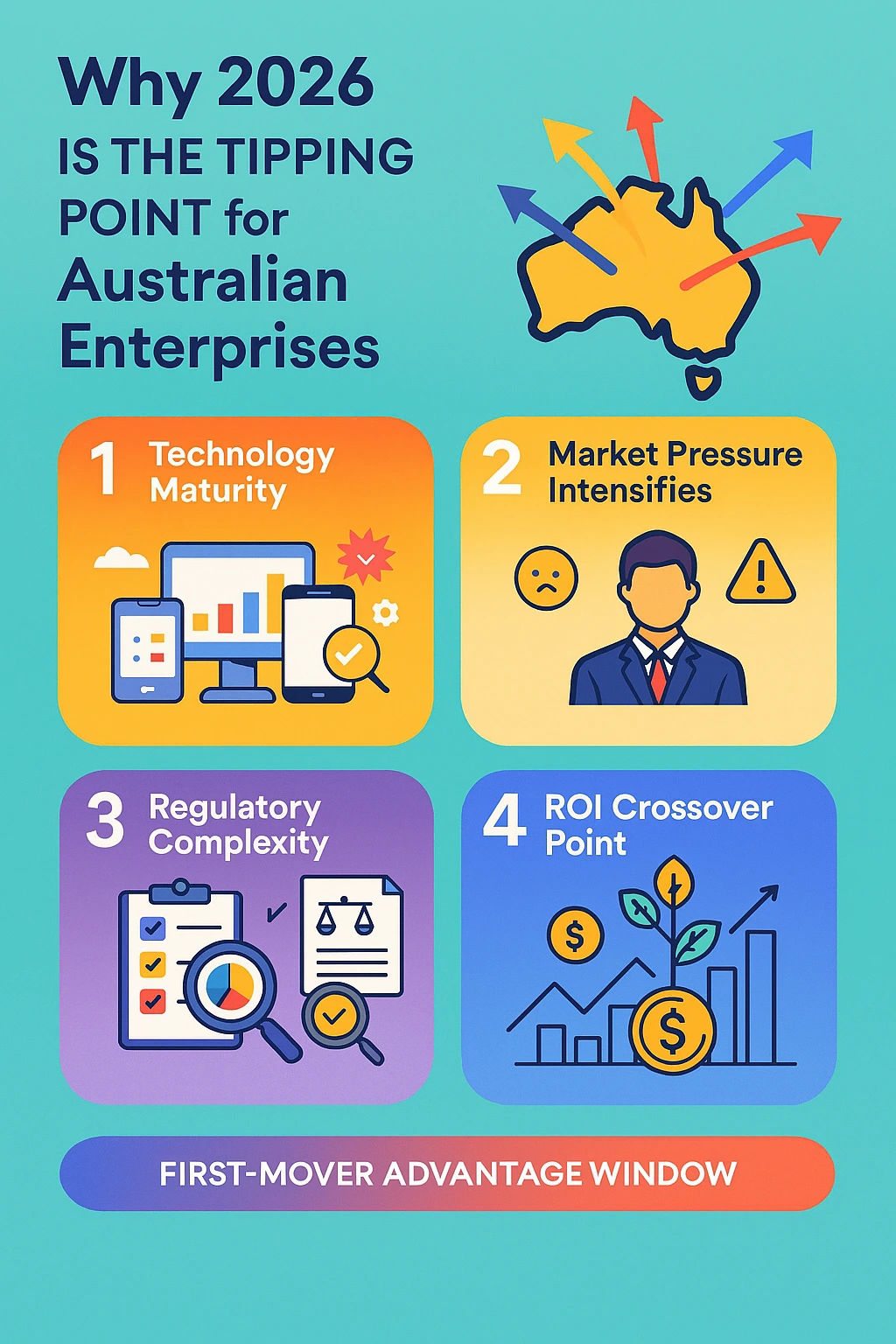
Four powerful forces are converging to make multi-agent orchestration not just viable, but essential:
1. Technology Maturity
The building blocks have finally aligned. LLMs reached production-ready reliability, API-first architectures became standard, cloud costs dropped 40% over three years, and integration platforms made system connectivity affordable. What was experimental in 2023 is now proven infrastructure in 2026.
2. Market Pressure Intensifies
Australian businesses face unique challenges. Average enterprise employee costs exceed $120,000 annually (salary plus superannuation plus benefits). We have 87,000+ unfilled tech positions creating critical skill shortages. Global competitors operate with lower cost bases, whilst customer expectations have shifted—same-day service is now baseline, not premium.
3. Regulatory Complexity
New compliance requirements are actually accelerating automation adoption. Privacy Act amendments increase data handling complexity. Industry-specific regulations (APRA, ASIC, TGA) require detailed audit trails. Upcoming AI governance frameworks demand transparent decision-making. ESG reporting mandates need automated data collection.
Multi-agent systems provide the audit trails and transparency Australian regulators increasingly require.
4. ROI Crossover Point
The economics finally make compelling sense. Implementation costs have dropped 60% since 2022 through standardised platforms and proven methodologies. Maintenance costs are 70% lower than traditional automation due to self-healing capabilities. Payback periods now average 12-18 months versus 36+ months previously. Most importantly, we now have proven case studies replacing experimental pilots.
The First-Mover Advantage Window
Technology leaders (2024-2025): Gaining competitive advantages but still refining approaches
Early majority (2026-2027): Perfect timing—learn from pioneers, still ahead of competitors
Late majority (2028+): Playing catch-up, paying premiums for urgent implementations
Laggards (2029+): Struggling to compete, may not survive the digital transformation gap
Australian businesses moving in 2026 avoid the 2027-2028 implementation bottleneck when demand will exceed quality developer capacity.
Real ROI: What Australian Businesses Are Actually Saving
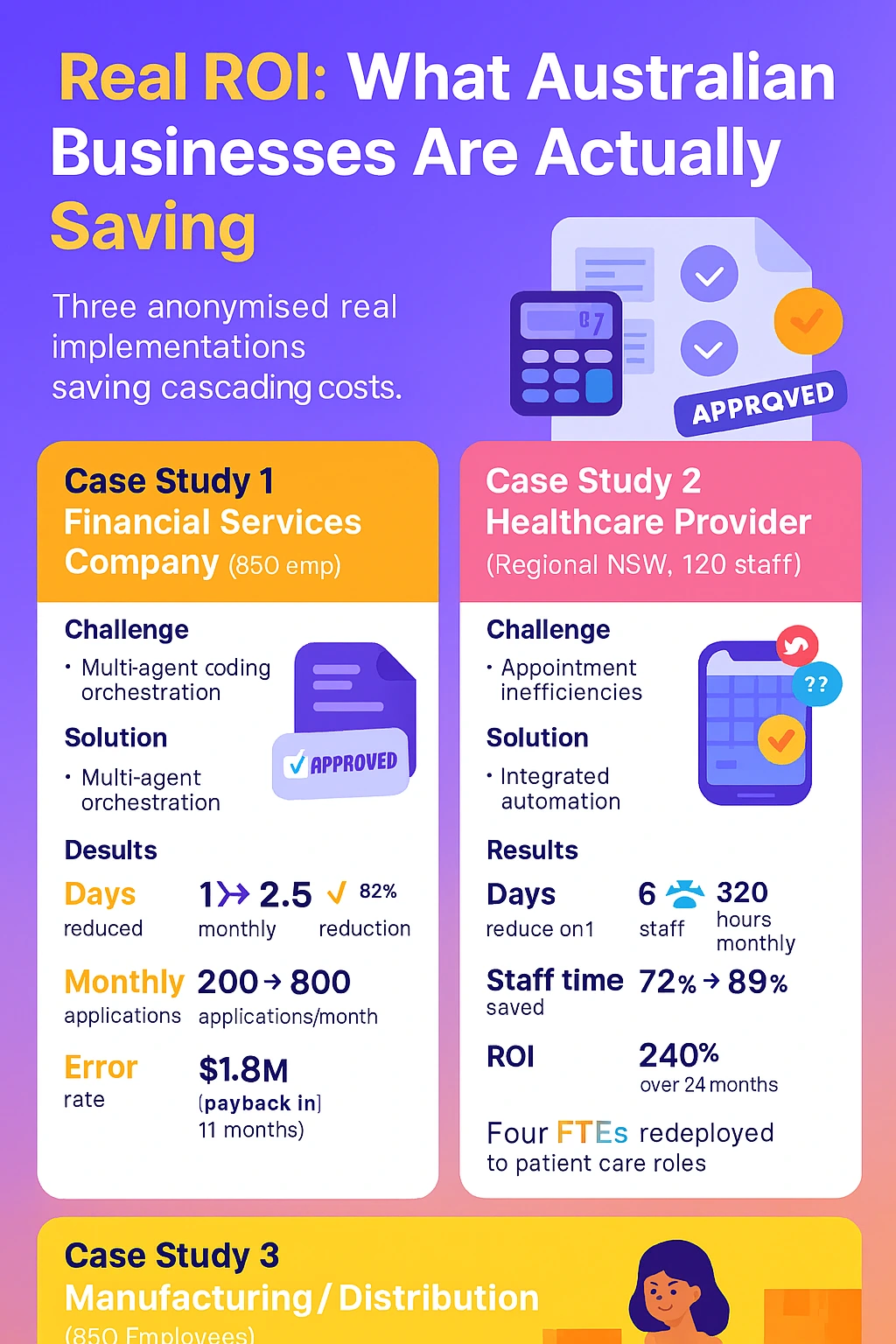
Let's examine three actual implementations (anonymised Australian clients):
Case Study 1: Financial Services Company (350 Employees)
Challenge: Customer onboarding took 14 days, involving 8 departments and 47 manual steps. Compliance requirements increased documentation by 40% in 2024.
Solution: Multi-agent orchestration system with specialised agents for document verification, credit checks, compliance screening, account setup, and communication management.
Results:
- Onboarding time: 14 days → 2.5 days (82% reduction)
- Processing costs: $340 per customer → $85 per customer (75% reduction)
- Volume capacity: 200 → 800 applications/month (4x increase)
- Error rate: 8.5% → 0.4% (95% reduction)
- Annual savings: $1.8M (payback in 11 months)
Case Study 2: Healthcare Provider (Regional NSW, 120 Staff)
Challenge: Claims processing backlog, appointment scheduling inefficiencies, patient communication gaps.
Solution: Integrated multi-agent system handling claims validation and submission, appointment optimisation, patient follow-up communications, and inventory management.
Results:
- Claims processing: 6 days → 18 hours (75% faster)
- Staff time saved: 320 hours monthly
- Patient satisfaction: 72% → 89%
- ROI: 240% over 24 months
- Four FTEs redeployed to patient care roles
Case Study 3: Manufacturing/Distribution (850 Employees)
Challenge: Supply chain inefficiencies, inventory inaccuracies, order processing delays.
Solution: Multi-agent orchestration across procurement, inventory, fulfilment, and customer service.
Results:
- Order accuracy: 91% → 99.2%
- Fulfilment time: 4.2 days → 1.8 days
- Inventory carrying costs: Reduced 28%
- Stockout incidents: Down 67%
- Annual impact: $3.2M savings plus $1.1M revenue gain from faster delivery
The ROI Framework
Direct cost savings include:
- Labour cost reduction (20-40% of process costs through redeployment, not elimination)
- Error reduction savings (financial errors average $12,000 each, compliance violations $50,000-$500,000)
- Speed-to-market advantages (faster launches, improved working capital)
- Compliance and audit cost reductions (60% less staff time, reduced violation risk)
Indirect value creation includes:
- Customer experience improvements (24/7 service, higher satisfaction, improved retention)
- Data intelligence (automated insights, process optimisation, predictive analytics)
- Talent advantages (modern tech attracts candidates, reduced turnover, stronger employer brand)
- Scalability (handle 3-5x volume without proportional cost increases)
The Discovery Call: Your Most Important Investment

Here's a scenario playing out weekly in Australian businesses: A company decides they need enterprise process automation services. They Google developers, request quotes from five companies, receive "indicative pricing" ranging from $180K to $650K, choose the cheapest option at $180K based on a 30-minute phone call and a 12-page proposal.
Six months later: Project is 85% over budget ($333K spent, not finished), timeline blown out (6 months → 14 months projected), core features don't work as expected, integration with existing ERP was "out of scope," change requests cost $15K-40K each, and the relationship has deteriorated.
The root cause? They skipped proper discovery and jumped straight to implementation based on assumptions.
Why "Quick Quotes" Are Toxic
When developers provide pricing without thorough discovery, they're guessing. They don't know your actual process complexity, system integration landscape, data quality issues, compliance requirements, organisational change readiness, or technical debt.
Example: The hidden complexity
A company approached us for "simple automation" of invoice processing. After discovery, we found invoices came in 14 different formats (not "standard PDFs"), five different systems needed the data (not just accounting), three-way matching was required, approval workflows had eight different paths, a legacy AS/400 system required custom integration, data quality issues included 40% vendor master file duplicates, and the finance team feared job losses.
"Simple" project reality:
- Initial estimate (without discovery): $85K, 10 weeks
- Actual scope (after discovery): $340K, 32 weeks
- Difference: 400% cost variance, 320% timeline variance
Armed with accurate information, the company chose to phase the implementation: Phase 1 targeted the top five invoice formats and two systems for $120K over 14 weeks. This delivered on time and budget, saved $280K annually, and funded Phase 2 from savings.
Without discovery? They would have signed an $85K contract, hit massive overruns, blamed the developer, possibly cancelled the project, and wasted money and organisational trust.
What Proper Discovery Looks Like
A professional discovery process spans 2-4 weeks and includes initial assessment (understanding pain points, technology landscape, constraints, success criteria), technical workshops (process mapping, system architecture review, data discovery, stakeholder interviews), solution design (architecture planning, accurate effort estimation, phased roadmap), and commercial agreement (transparent pricing, risk mitigation, success metrics).
Discovery investment: $15K-35K depending on complexity
What it prevents:
| Risk |
Probability Without Discovery |
Average Cost |
Expected Loss |
| 50%+ budget overrun |
65% |
$150K |
$97.5K |
| Timeline delay (6+ months) |
55% |
$80K |
$44K |
| Failed integration |
40% |
$120K |
$48K |
| Major scope gaps |
25% |
$200K |
$50K |
| Wrong technology choice |
30% |
$180K |
$54K |
| TOTAL EXPECTED LOSS |
- |
- |
$293.5K |
Discovery ROI: $293.5K prevented / $25K invested = 11.7x return
Discovery feels like a delay and extra cost. But it's actually project insurance preventing the catastrophic failures that plague 60%+ of enterprise software projects.
The "AI Cowboy" Problem: Why Cheap Becomes Expensive
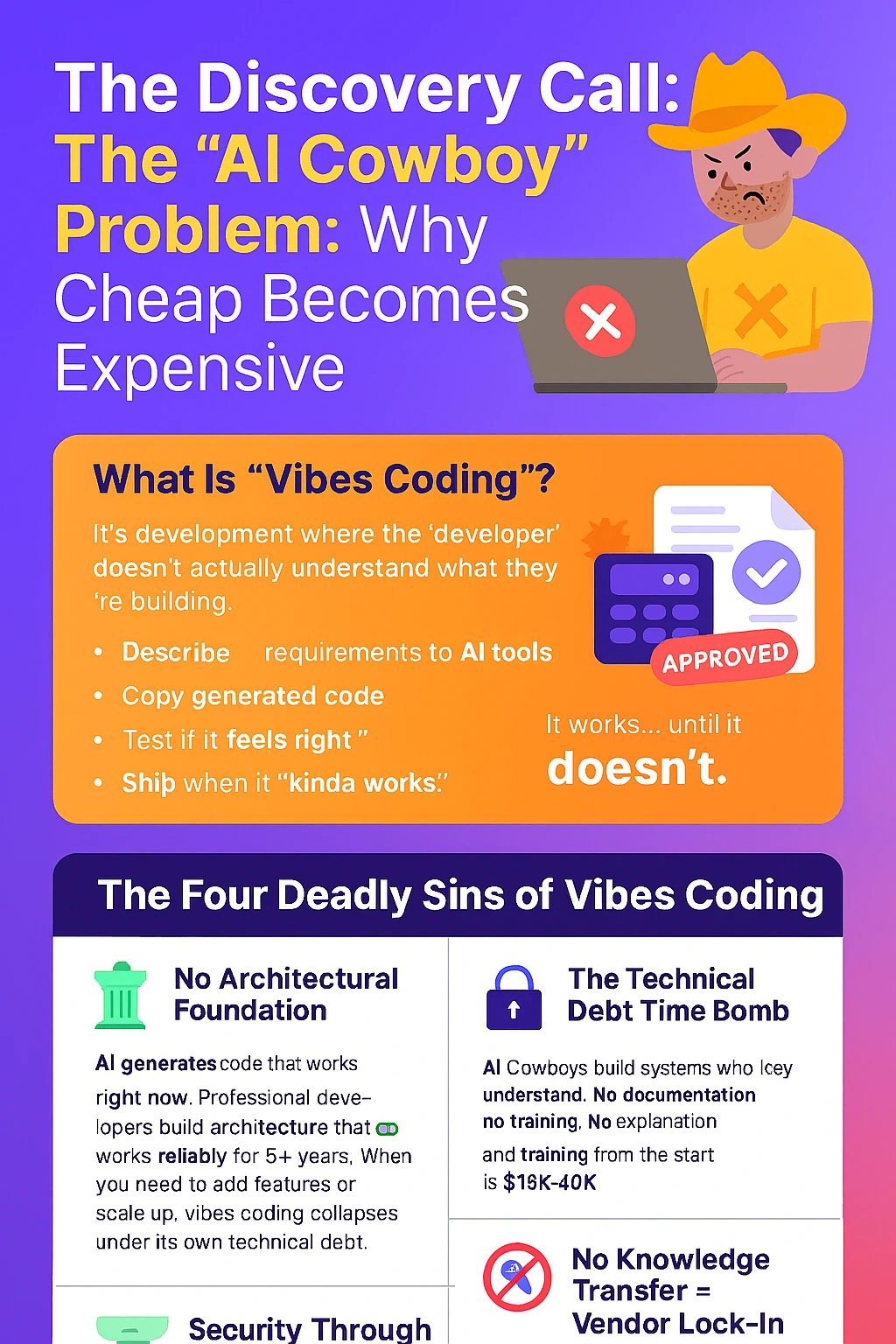
There's a new breed of "developers" flooding the Australian market: AI Cowboys (also called "AI app builders" or "prompt engineers"). They learned to code in 2023-2024 using ChatGPT or Claude, can build functional prototypes quickly, and charge 40-70% less than established firms.
What Is "Vibes Coding"?
It's development where the "developer" doesn't actually understand what they're building. They describe requirements to AI tools, copy generated code without understanding it, test if it "feels right," and ship when it "kinda works."
It works... until it doesn't.
Real Australian example: A retail company hired an "AI automation specialist" for $75K to build customer service orchestration (quoted 10 weeks). Weeks 1-6 seemed great—demos looked impressive, basic functionality worked. Week 7 production deployment: system crashed under actual load, customer data was briefly visible to wrong users (security flaw), and Shopify integration lost three hours of orders ($47K in lost sales).
The developer couldn't explain why issues occurred. Fixes broke other functionality. The code was unmaintainable. C9 was brought in for rescue: 70% needed rebuilding from scratch due to no proper architecture, security vulnerabilities, scalability issues, and integration fragility.
Total cost: $185K to fix + $47K lost revenue + 12 weeks delay = $232K (309% over original quote)
Would have been $220K if done properly from the start.
The Four Deadly Sins of Vibes Coding
Sin 1: No Architectural Foundation
AI generates code that works right now. Professional developers build architecture that works reliably for 5+ years. When you need to add features or scale up, vibes coding collapses under its own technical debt.
Sin 2: Security Through Ignorance
Real vulnerabilities found in AI Cowboy code include SQL injection vulnerabilities, authentication bypasses, exposed API keys in client-side code, no input validation, and Privacy Act violations. The average cost of a data breach in Australia is $3.35M. The cost of proper security from the start is $15K-40K included in professional development.
Sin 3: The Technical Debt Time Bomb
Technical debt compounds like financial debt. Year 1 works fine. Year 2, adding features costs 3x what it should in well-architected systems. Year 3, you face band-aid fixes or costly rebuilds. Total cost over three years often exceeds 2x the proper development cost.
Sin 4: No Knowledge Transfer = Vendor Lock-In
AI Cowboys build systems only they understand. No documentation, no training, no explanation of decisions. You're trapped. Professional developers (like C9) deliver complete documentation, architecture decision records, training sessions, and code following industry standards. You own the IP and knowledge.
Why Professional Developers Still Matter
What AI coding tools ARE good for: Boilerplate generation, syntax suggestions, documentation generation, test case creation, code explanation.
What AI CANNOT do: Understand your business context, make architectural decisions for scalability, design for security and compliance, anticipate edge cases, debug complex integrations, optimise for real-world performance, or architect systems that evolve with business needs.
At C9, our developers use AI to accelerate routine tasks (30-40% productivity gain) whilst applying two decades of architectural knowledge AI doesn't have. We review AI-generated code with expert eyes, catching issues AI misses. You get speed AND quality, not a choice between them.
Why Choose C9 Among Hundreds of Australian Developers

The Australian enterprise development landscape has 500+ companies offering "enterprise automation services." They range from Big 4 consulting firms ($300-500/hour, bureaucratic, one-size-fits-all) to small freelancers ($80-150/hour, key person risk, inconsistent quality).
C9 is a boutique specialist with enterprise capabilities—the best of both worlds.
C9's Unique Blended Hybrid Model
This isn't just "outsourcing." It's a strategically designed team model:
Onshore (Australian-based):
- Senior architects and solution designers
- Project managers and client relationship owners
- Business analysts understanding Australian context
- QA leads and compliance specialists
Offshore (Directly employed by C9, not contractors):
- Senior developers with 8-15 years' experience
- Specialised engineers (AI/ML, integrations, DevOps)
- QA engineers and automation specialists
- Technical writers and documentation specialists
Critical distinction: These aren't "cheap offshore contractors" hired per project. They're permanent C9 employees averaging 3.5 years' tenure, trained in Australian business practices and compliance, experienced with Australian systems (MYOB, Xero, BankLink), and working overlap hours with Australian business days.
Why this works:
- Cost efficiency (30-40% savings versus all-Australian teams)
- Quality maintained through Australian oversight
- Scalability (access to specialised skills, no capacity constraints)
- Risk mitigation (distributed knowledge, no single-person dependency)
Knowledge Transfer as Core Competency
C9 builds capability, not dependency. During development, your team receives weekly technical reviews, architecture walkthroughs, code explanations, and shadowing opportunities. At delivery, you get comprehensive documentation, recorded training sessions, hands-on workshops, and operational playbooks. Post-delivery includes 30-60 day knowledge transfer period, tier 1 support transition, and documented Q&A for your reference.
The goal: After 3-6 months, your team understands the architecture, can make modifications, troubleshoots common issues, and confidently maintains the system—whether you continue with C9 or not.
Transparent, Skill-Based Pricing
Unlike agencies charging one rate for everyone, C9 prices based on actual skill requirements:
- Junior developers: $70-90/hour (bug fixes, routine maintenance)
- Mid-level developers: $95-125/hour (standard features, integrations)
- Senior developers: $130-165/hour (complex features, architecture)
- Specialists (AI/ML, DevOps): $140-180/hour
- Australian architects: $185-230/hour (solution design, workshops)
- Australian project managers: $160-200/hour
Typical project blend: $135-155/hour effective rate (35% savings versus traditional agencies). You see exactly who's doing what at what rate, ensuring right skill levels for each task.
Staff Augmentation: Flexible Enterprise Process Automation Services
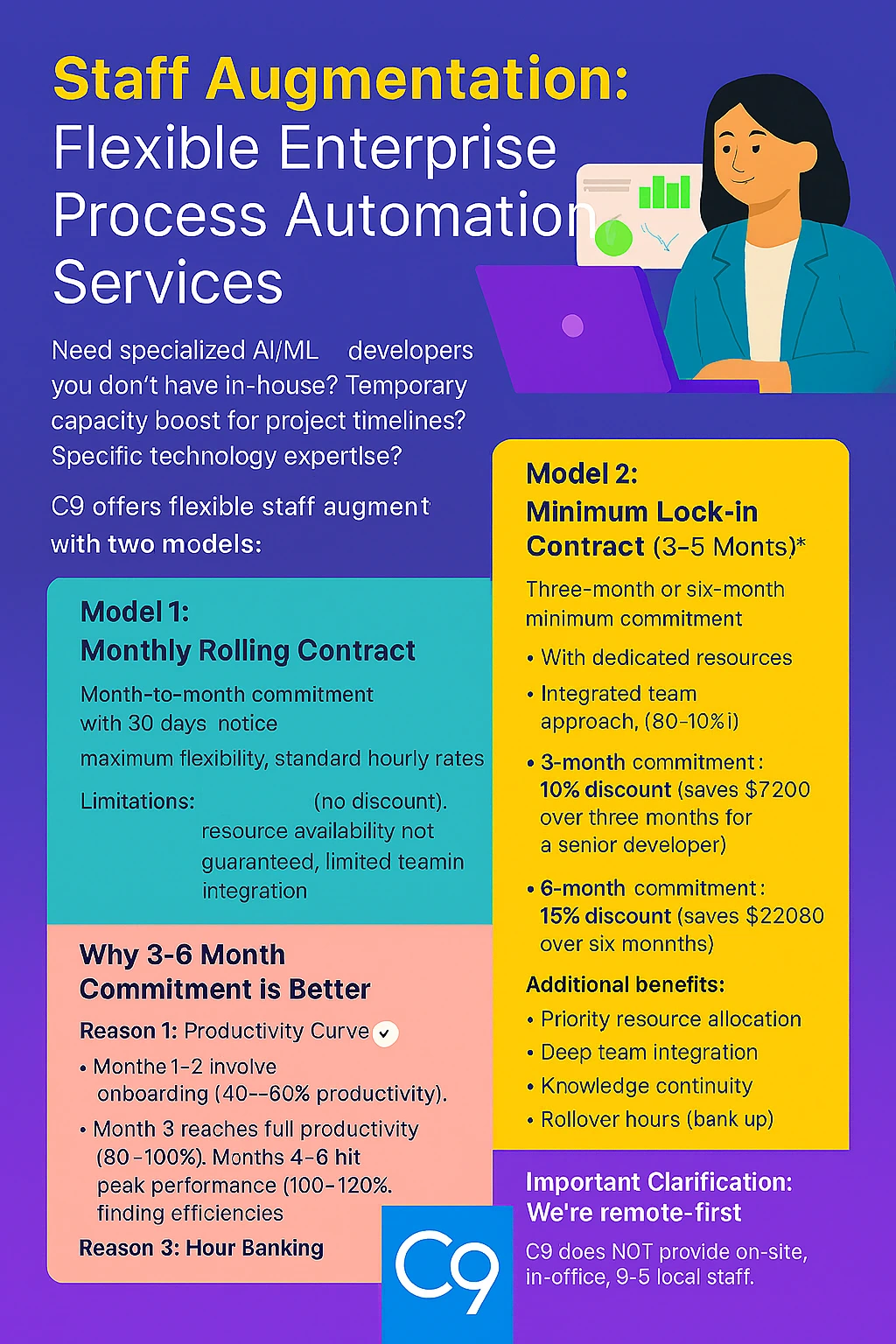
Need specialised AI/ML developers you don't have in-house? Temporary capacity boost for project timelines? Specific technology expertise? C9 offers flexible staff augmentation with two models:
Model 1: Monthly Rolling Contract
Month-to-month commitment with 30 days' notice, maximum flexibility, standard hourly rates. Best for experimental pilots, uncertain scope, or very small engagements (1-2 months total).
Limitations: Higher rates (no discount), resource availability not guaranteed, limited team integration.
Model 2: Minimum Lock-In Contract (3-6 Months)
Three-month or six-month minimum commitment with dedicated resources, integrated team approach, and partnership pricing.
3-month commitment: 10% discount (saves $7,200 over three months for a senior developer)
6-month commitment: 15% discount (saves $22,080 over six months)
Additional benefits: Priority resource allocation, deep team integration, knowledge continuity, rollover hours (bank unused hours for future use), and predictable budgeting.
Why 3-6 Month Commitment Is Better
Reason 1: Productivity Curve
Months 1-2 involve onboarding (40-60% productivity). Month 3 reaches full productivity (80-100%). Months 4-6 hit peak performance (100-120%, finding efficiencies). Monthly contracts often end just as developers reach peak productivity—you paid for ramp-up but missed full value.
Reason 2: Knowledge Retention
Monthly contracts lead to rotating resources and constant re-onboarding. Six-month contracts allow deep system knowledge to build, architecture improvements in month 4, and compounding productivity gains—estimated 30-40% efficiency improvement in months 3-6 versus rotating resources.
Reason 3: Hour Banking
Unique C9 feature: commit to monthly hours (e.g., 160), actual usage varies, unused hours roll over (up to 25% of commitment), use banked hours for future features or intensive phases. This flexibility without waste is unavailable on monthly contracts.
Important Clarification: We're Remote-First
C9 does NOT provide on-site, in-office, 9-5 local staff. We're remote-first with distributed teams, Australian project managers during business hours, video collaboration tools, offshore team overlap hours (typically 7am-11am AEST), and periodic face-to-face workshops for major projects.
Best fit: Companies comfortable with modern remote collaboration, focusing on outcomes over physical presence. If you require office attendance, C9 isn't the right fit.
Indicative Pricing vs Discovery-Based Accuracy
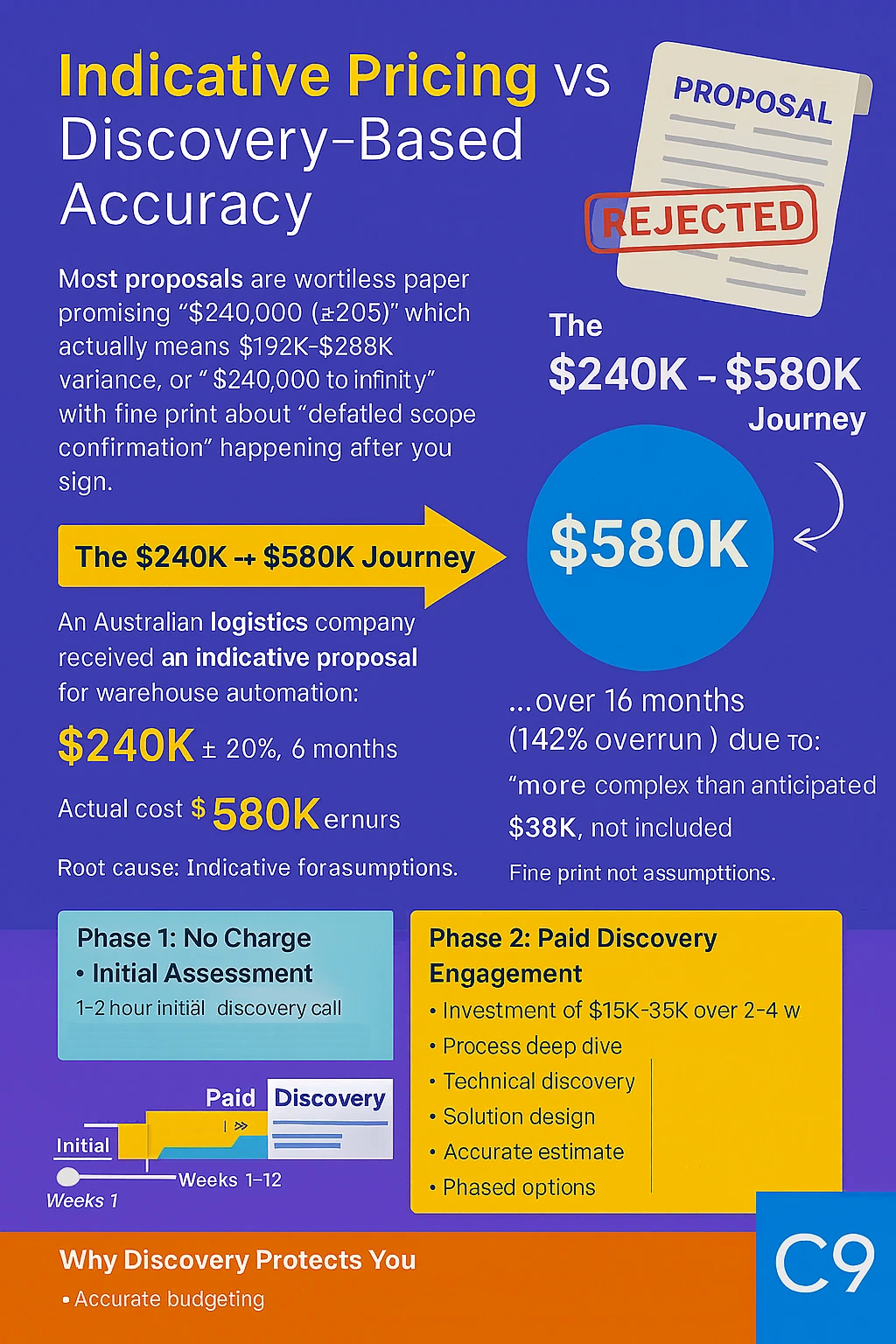
Most proposals are worthless paper promising "$240,000 (±20%)" which actually means $192K-$288K variance, or "$240,000 to infinity" with fine print about "detailed scope confirmation" happening after you sign.
Real Example: The $240K → $580K Journey
An Australian logistics company received an indicative proposal for warehouse automation: $240K ± 20%, 6 months. Actual costs totalled $580K over 16 months (142% overrun) due to "more complex than anticipated" discovery ($42K versus $25K), "additional design phase required" ($38K, not included), integration and data migration complexity ($295K versus $180K), extended testing ($71K versus $35K), phased rollout requirements ($47K, not included), and 22 change requests averaging $4K each ($87K total).
Root cause: Indicative pricing based on assumptions never validated.
How C9 Does It Differently
Phase 1: Initial Assessment (No Charge)
1-2 hour discovery call assessing feasibility and fit. We tell you if we're NOT the right fit, if your project isn't ready, or if there's a simpler solution. Deliverable: Rough order of magnitude with explicitly wide range.
Example: "Based on initial discussion, this project falls in the $180K-$420K range (133% variance). This is TOO WIDE to be useful. We need proper discovery to narrow this to ±15-20%."
We explicitly state the range is unreliable. No false precision.
Phase 2: Paid Discovery Engagement
Investment of $15K-35K over 2-4 weeks delivers detailed project plan with accurate pricing. Discovery includes process and requirement deep-dive (workshops, mapping, pain points, constraints), technical discovery (system audit, API review, data assessment, infrastructure evaluation), solution design (architecture, integration approach, phased roadmap, risk strategies), and accurate estimation (to the HOUR for standard tasks, to the DAY for complex components, explicit assumptions, risk buffer explained).
Example Detailed Estimate:
Phase 1: Foundation (Weeks 1-12)
├─ Architecture Setup: 80 hours @ $185/hr = $14,800
├─ Core Agent Development: 420 hours @ $145/hr = $60,900
├─ Orchestrator Development: 200 hours @ $155/hr = $31,000
├─ Integration Development: 240 hours @ $140/hr = $33,600
├─ Testing & QA: 160 hours @ $110/hr = $17,600
├─ Project Management: 120 hours @ $175/hr = $21,000
└─ Risk Buffer (12%): $19,680
Phase 1 Total: $197,980 (±12%)
Actual Range: $174,222 - $221,738
Note the difference: Indicative "$180K ± 20%" (hiding unknowns) versus discovery-based "$198K + 12%" (with explicit risk buffer for identified risks).
Why Discovery Protects You
Discovery provides accurate budgeting (know real cost upfront, make informed decisions), aligned expectations (both parties understand scope, change process defined), risk identification (surfaced early with mitigation strategies), phased approach options (break into stages, prove ROI, exit points), and competitive evaluation (compare accurate proposals fairly).
Phased Implementation: Early ROI Funds Future Improvements
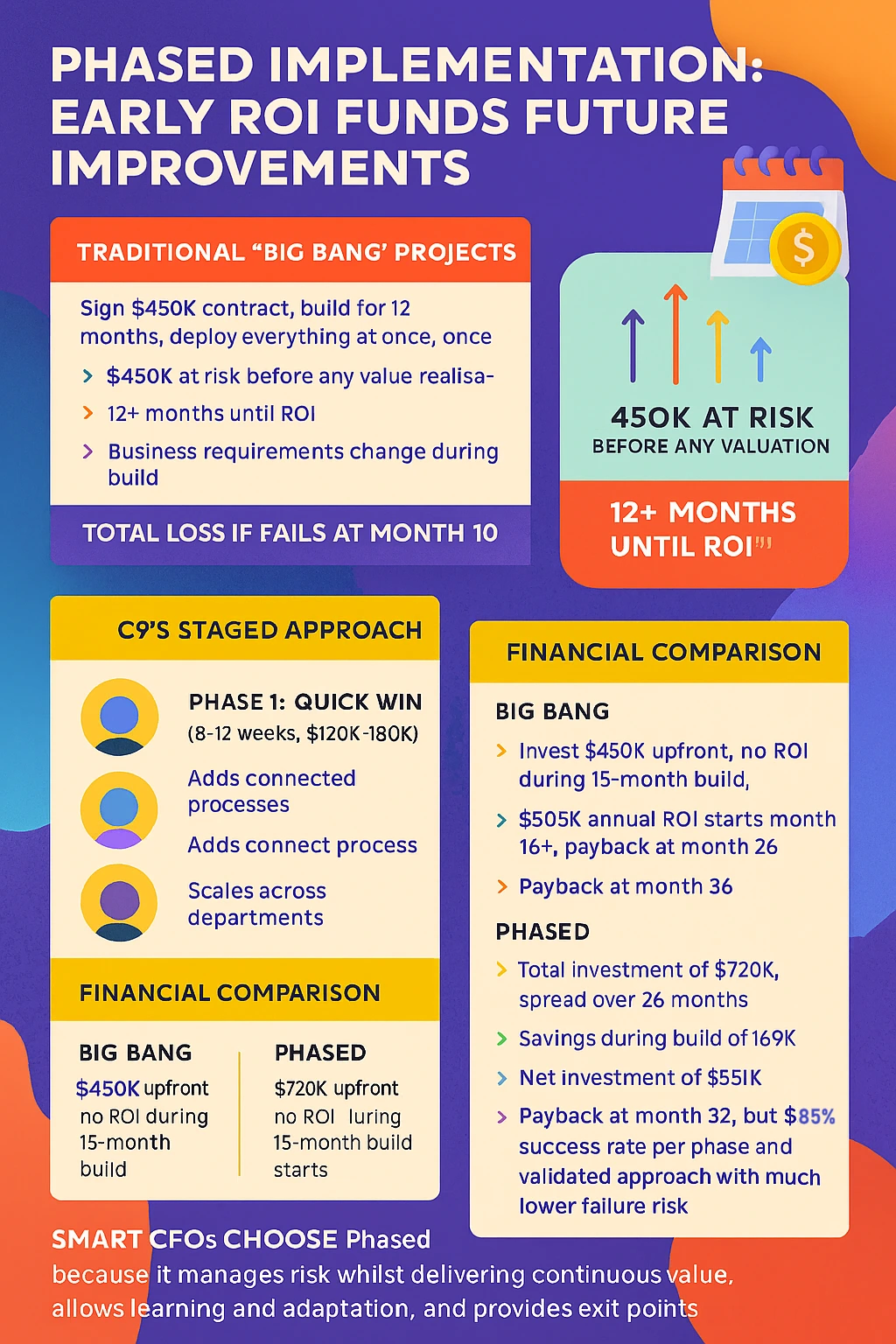
Traditional "big bang" projects sign $450K contracts, build for 12 months, deploy everything at once, and start seeing ROI in month 13+. This puts $450K at risk before any value realisation, takes 12+ months before ROI starts, risks business requirement changes during the build, and faces total loss if the project fails at month 10.
C9's Staged Approach
Phase 1: Quick Win (8-12 weeks, $120K-180K)
Focus on highest-pain, fastest-ROI process. Example: automate invoice processing targeting 2 FTEs spending 30 hours weekly on manual data entry. Solution: document processing agent, validation agent, simple routing. Expected ROI: $85K annually. Payback: 18-24 months from Phase 1 alone.
Deliverable: working system handling 70% of invoices, proof of concept for stakeholders, user feedback for planning, ROI validation before further investment.
Phase 2: Expansion (12-16 weeks, $180K-280K)
Build on Phase 1 success, add connected processes. Example: extend to purchase orders and vendor management. Expected incremental ROI: $140K annually. Cumulative ROI: $225K annually. Funding: Phase 1 savings ($21K over six months) plus budget reallocation.
Phase 3: Enterprise Scale (16-24 weeks, $240K-400K)
Scale across departments, add advanced capabilities. Example: full procure-to-pay automation including contract management, spend analytics, supplier performance tracking, predictive ordering. Expected incremental ROI: $280K annually. Cumulative ROI: $505K annually. Funding: Phases 1-2 generated $337K in savings over 18 months, funding majority of Phase 3.
Financial Comparison
Big Bang: Invest $450K upfront, no ROI during 15-month build, $505K annual ROI starts month 16+, payback at month 26 (but 40% chance of project failure = $180K expected loss risk).
Phased: Total investment of $720K spread over 26 months, savings during build of $169K, net investment of $551K, payback at month 32, but 85% success rate per phase and validated approach with much lower failure risk.
Smart CFOs choose phased because it manages risk whilst delivering continuous value, allows learning and adaptation, and provides exit points if priorities change.
Is Your Business Ready? Take the Assessment

Score each item 1-5 (1 = not ready, 5 = very ready):
Business Readiness:
- Clear pain points costing $200K+ annually
- Executive sponsorship (C-level champion committed)
- Budget allocated or accessible ($150K+ for Phase 1)
- Timeline flexibility (12+ weeks minimum)
- Realistic ROI expectations (18-24 month payback acceptable)
Technical Readiness:
- Systems have APIs or integration capability
- Data quality is reasonable (or willingness to address)
- Cloud infrastructure exists or willingness to adopt
- IT team supportive (or at least not blocking)
- Documentation of current processes exists
Organisational Readiness:
- Change management capability (successful technology adoption history)
- Stakeholder alignment (departments willing to collaborate)
- User openness (employees see opportunity, not threat)
- Process flexibility (willing to redesign, not just automate bad processes)
- Long-term commitment (not looking for quick fix)
Scoring:
- 60-75 points: Excellent readiness—proceed with confidence
- 45-59 points: Good readiness—address gaps during discovery
- 30-44 points: Moderate readiness—foundational work needed first
- Below 30: Not ready—focus on prerequisites before automation
Key insight: Scores below 45 don't mean "don't do this." They mean "do discovery to create a readiness roadmap." C9's discovery identifies prerequisites and creates mitigation plans.
Take Action: Book Your Discovery Call with C9
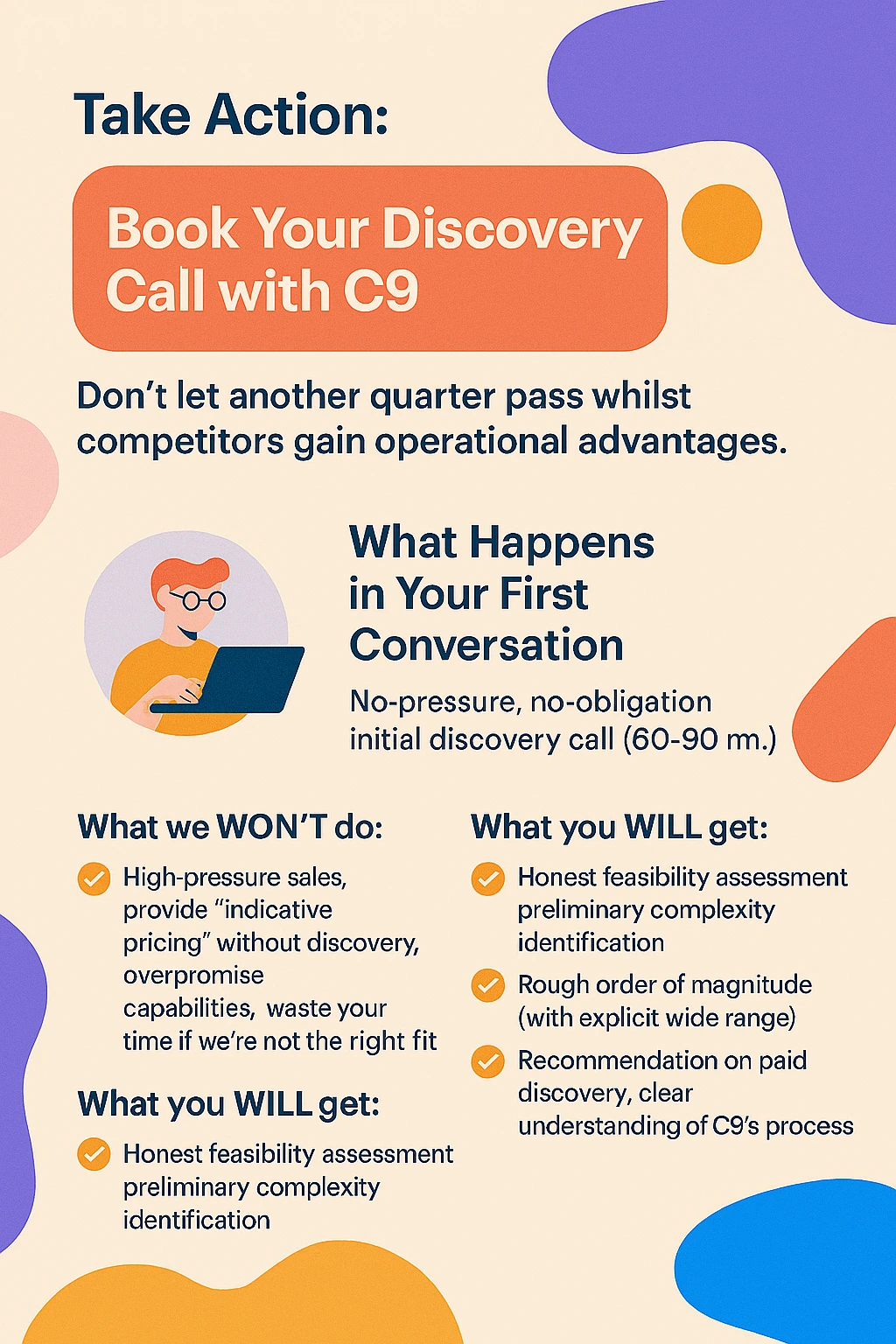
Don't let another quarter pass whilst competitors gain operational advantages.
What Happens in Your First Conversation
No-pressure, no-obligation initial discovery call (60-90 minutes)
We'll cover your business context (what's driving automation interest, what processes cause pain, what's the business impact, what's the urgency), current state assessment (systems involved, what's been tried, constraints, key stakeholders), feasibility and fit discussion (is multi-agent orchestration right, is C9 the right partner, what would success look like, primary risks), and next steps recommendation (if we're a good fit, propose paid discovery; if not, honest feedback on why and alternatives).
What we WON'T do: High-pressure sales, provide "indicative pricing" without discovery, overpromise capabilities, waste your time if we're not the right fit.
What you WILL get: Honest feasibility assessment, preliminary complexity identification, rough order of magnitude (with explicit wide range), recommendation on paid discovery, clear understanding of C9's process.
How to Book
Visit: www.c9.com.au/contact
Email: [email protected]
Subject: "Multi-Agent Orchestration Discovery Call"
Include: Company name, industry, brief description of interest
We respond within 24 business hours.
Prepare for the call by having ready: process documentation (if available), system landscape diagram (if available), list of pain points with estimated business impact, key stakeholders who should join (optional), and questions you want answered.
Within 48 hours post-call, you'll receive a summary of discussion, preliminary feasibility assessment, recommendation on next steps, paid discovery proposal (if applicable), with no obligation and no pressure.
Conclusion: The Future Belongs to the Prepared

Australian enterprises are at an inflection point. Multi-agent AI orchestration isn't science fiction—it's production reality delivering measurable ROI in businesses across Australia right now.
The costs of delay compound: Every month waiting is operational efficiency your competitors gain. Every quarter delayed is market share potentially lost. Every year postponed is a widening capability gap.
But rushing in blindly is equally dangerous: Cheap promises lead to expensive failures. Indicative pricing hides catastrophic overruns. AI Cowboys deliver technical debt time bombs. Poor planning wastes investments and organisational trust.
The winning path: ✅ Start with proper discovery
✅ Build in phases for early ROI
✅ Choose partners who transfer knowledge, not create dependency
✅ Invest in quality that scales, not shortcuts that crumble
2026 is the year to act—strategically, deliberately, professionally.
There are two ways to think about enterprise process automation: expense mentality (minimise cost, choose cheapest, regret the "savings") or investment mentality (maximise ROI, right-sized solution, prove value first, compound returns).
Multi-agent orchestration done right isn't an expense—it's an investment generating returns for years.
At C9, we're committed to being the partner Australian enterprises deserve: honest about complexity, transparent about costs, focused on your success, building your capability (not our dependency).
The future of your business operations is autonomous, intelligent, and scalable. Let's build it together.
Ready to Transform Your Enterprise Operations?
Book your complimentary discovery call with C9 today.
🔗 Visit: www.c9.com.au
C9: Australia's Leading Custom Software, Apps, Integration & Database Developer
Specialising in enterprise process automation services, multi-agent AI orchestration, system integration, and custom software development for Australian businesses.
Proudly Australian-owned. Serving enterprises across financial services, healthcare, manufacturing, professional services, retail, and government sectors.